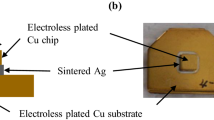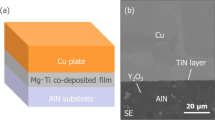Abstract
The use of a Co-W-P metallization substrate in SiC power modules is expected to improve high temperature reliability because Co-W-P metallization has been found to induce strong bonding strength to both sintered Ag joints and encapsulation resins. To progress in the development of this technology, the successful applicability of Co-W-P metallization into the module fabrication process is of critical importance. In this paper, the effects of annealing a Co-W-P metallization substrate in the die attach process onto its resin adhesion was studied with representative annealing conditions for Ag sintering. Initially, mild annealing at 200 °C for 1 h was applied and showed strong resin adhesion greater than 15 MPa at 225 °C and an ideal cohesion fracture mode of resin, the same as that found in that of the fresh Co-W-P case. However, more severe annealing resulted in lower resin adhesion. For example, annealing at 280 °C for 1 h resulted in a poor resin adhesion below 15 MPa, as well as a delamination fracture mode between the resin and the Co-W-P metallization. This mechanism was investigated with the use of SEM–EDS and XPS analysis. It was observed that annealing at 200 °C induced a slight oxidization of Co, but Co(OH)2 for the chemical reaction to resin, still remained on the Co-W-P surface. On the other hand, annealing at 280 °C formed an alternative main component (CoO). The shortage of Co(OH)2 on the top surface created by severe oxidization was found to induce poor resin adhesion. The results from this research are significant to future designs and applications of a module fabrication process using Co-W-P metallization substrates, as well as to the fundamental understanding of adhesion behavior on Co-W-P metallization.












Similar content being viewed by others
References
C. Buttay, D. Planson, B. Allard, D. Bergogne, P. Bevilacqua, C. Joubert, M. Lazar, C. Martin, H. Morel, D. Tournier, C. Raynaud, State of the art of high temperature power electronics. Mater. Sci. Eng., B 176, 283–288 (2011)
K. Hamada, M. Nagao, M. Ajioka, F. Kawai, SiC-emerging power device technology for next-generation electrically powered environmentally friendly vehicles. IEEE Trans. Electron Devices 62, 278–285 (2015)
R.W. Johnson, J.L. Evans, P. Jacobsen, J.R. Thompson, M. Christopher, The changing automotive environment: high-temperature electronics. IEEE Trans. Electron. Packag. Manuf. 27, 164–176 (2004)
P.O. Quintero, F.P. McCluskey, Temperature cycling reliability of high-temperature lead-free die-attach technologies. IEEE Trans. Device Mater. Reliab. 11, 531–539 (2011)
M. Bouarroudj, Z. Khatir, J.P. Ousten, S. Lefebvre, Temperature-level effect on solder lifetime during thermal cycling of power module. IEEE Trans. Device Mater. Reliab. 8, 471–477 (2008)
R. Khazaka, L. Mendizabal, D. Henry, R. Hanna, Survey of high-temperature reliability of power electronics packaging components. IEEE Trans. Power Electron. 30, 2456–2464 (2015)
F. Yu, J. Cui, Z. Zhou, K. Fang, R.W. Johnson, M.C. Hamilton, Reliability of Ag sintering for power semiconductor die attach in high-temperature applications. IEEE Trans. Power Electron. 32, 7083–7095 (2017)
C. Chen, K. Suganuma, T. Iwashige, K. Sugiura, K. Tsuruta, High-temperature reliability of sintered microporous Ag on electroplated Ag, Au, and sputtered Ag metallization substrates. J. Mater. Sci. 29, 1785–1797 (2018)
F. Iacona, M. Garilli, G. Marietta, O. Puglisi, S. Pignataro, Interfacial reactions in polyimide/metal systems. J. Mater. Res. 6, 861–870 (1991)
T. Iwashige, T. Endo, K. Sugiura, K. Tsuruta, Y. Sakuma, S. Kurosaka, Y. Oda, C. Chen, S. Nagao, K. Suganuma, CoW metallization for high strength bonding to both sintered Ag joints and encapsulation resins. J. Mater. Sci. 30, 11151–11163 (2019)
M. Kuramoto, S. Ogawa, M. Niwa, K.S. Kim, K. Suganuma, New silver paste for die-attaching ceramic light-emmiting diode package. IEEE Trans. Compon. Packag. Manuf. Technol. 33, 801–808 (2010)
H. Zhang, W. Li, Y. Gao, H. Zhang, J. Jiu, K. Suganuma, Enhancing Low-temperature and pressureless sintering of micron silver paste based on an ether-type solvent. J. Electron. Mater. 46, 5201–5208 (2017)
K.S. Siow, Mechanical properties of nano-silver joints as die attach materials. J. Alloy. Compd. 514, 6–19 (2012)
A. Herrera-Gomez, M. Bravo-Sanchez, O. Ceballos-Sanchez, M.O. Vazquez-Lepe, Practical methods for background subtraction in photoemission spectra. Surf. Interface Anal. 46, 897–905 (2014)
M.F. Koenig, J.T. Grant, Comparison of factor analysis and curve-fitting for data analysis in XPS. J. Electron Spectrosc. Relat. Phenom. 41, 145–156 (1986)
C.W. Chu, P.D. Murphy, Adhesion of polyimides to alumina without coupling agents. J. Adhes. Sci. Technol. 6, 1119–1135 (1992)
N.S. McIntyre, M.G. Cook, X-ray photoelectron studies on some oxides and hydroxides of cobalts, nickel, and copper. Anal. Chem. 47, 2208–2213 (1975)
M.C. Biesinger, B.P. Payne, A.P. Grosvenor, L.W.M. Lau, A.R. Gerson, R.St.C Smart, Resolving surface chemical states in XPS analysis of first row transition metals, oxides and hydroxides: Cr, Mn, Fe, Co and Ni. Appl. Surf. Sci. 257, 2717–2730 (2011)
Acknowledgements
This work was supported in part by the New Energy and Industrial Technology Development Organization (NEDO) project “Establishment of a high-density and miniaturization foundation technology for the application of SiC power module in high temperature” (Grant No. P10022).
Author information
Authors and Affiliations
Corresponding author
Additional information
Publisher's Note
Springer Nature remains neutral with regard to jurisdictional claims in published maps and institutional affiliations.
Rights and permissions
About this article
Cite this article
Iwashige, T., Endo, T., Sugiura, K. et al. Effect of annealing Co-W-P metallization substrate onto its resin adhesion. J Mater Sci: Mater Electron 30, 13247–13257 (2019). https://doi.org/10.1007/s10854-019-01688-0
Received:
Accepted:
Published:
Issue Date:
DOI: https://doi.org/10.1007/s10854-019-01688-0




